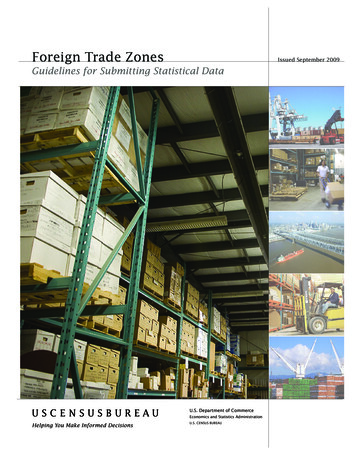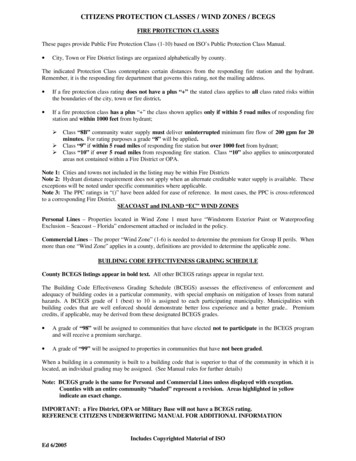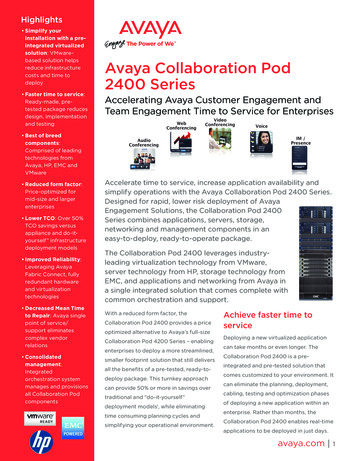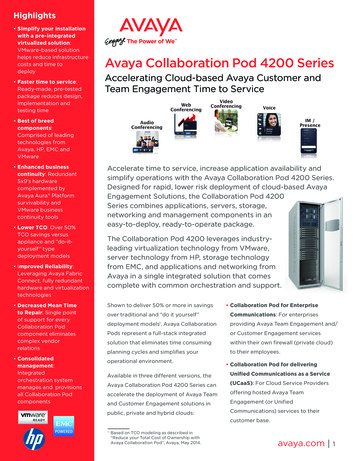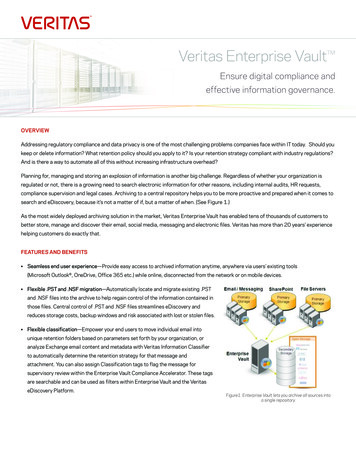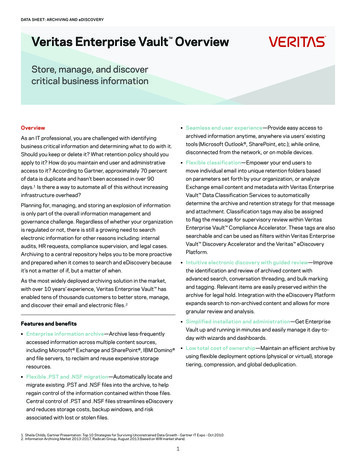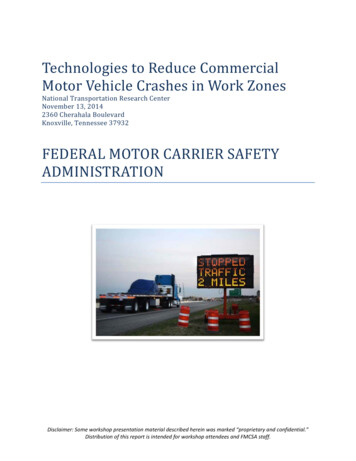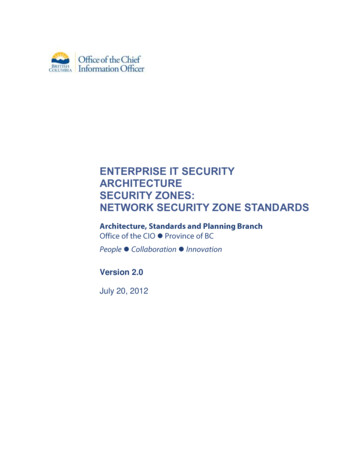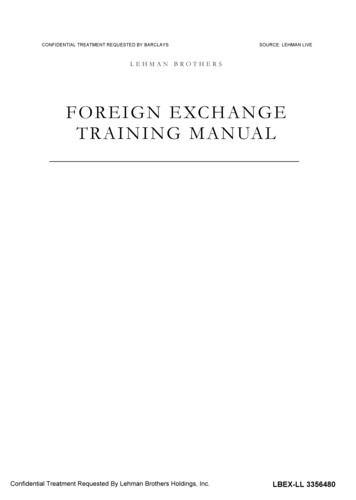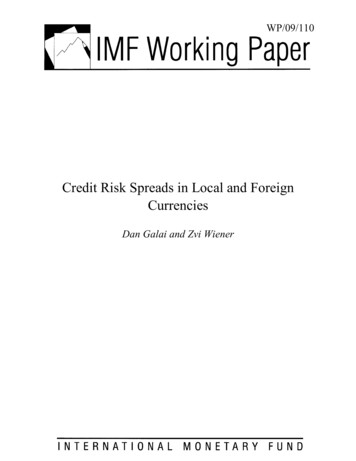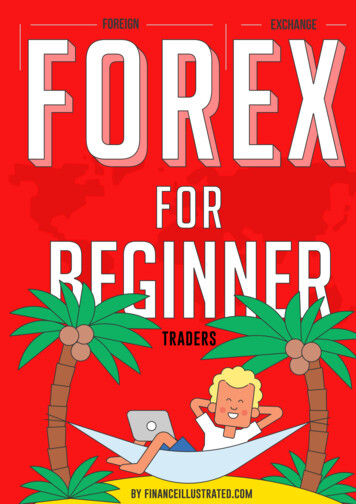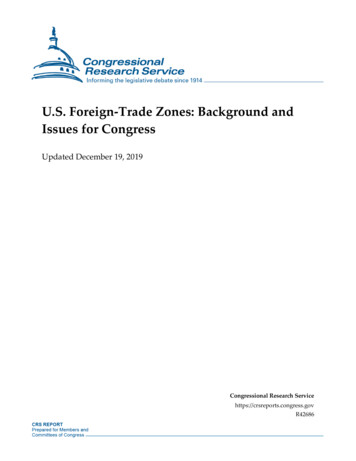
Transcription
U.S. Foreign-Trade Zones: Background andIssues for CongressUpdated December 19, 2019Congressional Research Servicehttps://crsreports.congress.govR42686
SUMMARYU.S. Foreign-Trade Zones: Background andIssues for CongressU.S. foreign-trade zones (FTZs) are geographic areas declared to be outside the normalcustoms territory of the United States. This means that, for foreign merchandise enteringFTZs and re-exported as different products, customs procedures are streamlined andtariffs do not apply. For products intended for U.S. consumption, full customsprocedures are applied and duties are payable when they exit the FTZ.R42686December 19, 2019Liana WongAnalyst in InternationalTrade and FinanceIn 1934, in the midst of the Great Depression, Congress passed the U.S. Foreign Trade Zones Act. It was designedto expedite and encourage international trade while promoting domestic activity and investment. The U.S. FTZprogram offers a variety of customs benefits to businesses which combine foreign and domestic merchandise inFTZs. Similar types of “zones” exist in 147 countries, employing roughly 90 to 100 million workers worldwide.Though some aspects differ, all have streamlined customs procedures and no duties applicable on components andraw materials combined in zones and then re-exported. The worldwide network of free trade zones facilitates theintegration of economies into global supply chains.U.S. FTZs can affect the competitiveness of U.S. companies by allowing savings through (1) duty reduction on“inverted tariff structures” (where tariffs are higher on imported components than on finished products); (2)customs and inventory efficiencies; and (3) duty exemption on goods exported from, or consumed, scrapped, ordestroyed in, a zone. Though difficult to achieve, other possible alternatives, such as broad-based tariff reductionsthrough multilateral negotiations, and overall customs reform might provide some of the same competitiveadvantages as zone use in a more efficient manner, while also ensuring that all importers have equal access.Zone activity represents a significant share of U.S. trade. According to the FTZ Board’s 2018 Annual Report toCongress, foreign goods entering the United States through FTZs accounted for almost 10% of total U.S. imports.Oil/petroleum (25%), vehicles and related parts (17%), and electronics (16%) made up the majority of foreigngoods entering FTZs. A majority of goods entering FTZs are used in production activities (63%), while theremaining are used in warehouse and other logistical activities (37%). Most goods (86%) arriving through FTZswere consumed in the United States; the rest were exported. The industries that account for a significant portionof zone production activity include the oil refining, automotive, electronics, and pharmaceutical sectors.Administration of the U.S. FTZ system is overseen by the Secretaries of Commerce and the Treasury, whoconstitute the U.S. FTZ Board. The Board is responsible for the establishment of zones, the authorization ofspecific production activity, and the general oversight of zones. It also appoints an Executive Secretary, whooversees the Board’s staff. Homeland Security’s Customs and Border Protection (CBP) directly oversees FTZsand enforces regulations set by the Board. It activates the zones and secures and controls dutiable merchandisemoving into and out of them. CBP oversight also includes both protection of U.S. tariff revenue and protectionfrom illegal activity through screening, targeting, and inspections.In 2012, the U.S. FTZ Board issued new regulations. They focused primarily on streamlining the applicationprocedures and shortening, generally from a year to four months, the time for FTZ approval for productionactivity under certain circumstances.Congressional InterestCongress has demonstrated a continuing interest in U.S. Foreign Trade Zones (FTZs), as they (1) may help tomaintain U.S. employment opportunities and the competitiveness of U.S. producers; (2) encompass a portion ofU.S. trade; and (3) affect U.S. tariff revenue. U.S. FTZs account for less than one-half of 1% of all world zoneworkers and a small share of the U.S. workforce. However, most of this employment is in manufacturing, whichhas lost a significant share of its workers over the past several decades. Today, every state has at least one FTZ,and many have numerous manufacturing operations.Congressional Research Service
U.S. Foreign-Trade Zones: Background and Issues for CongressCurrent issues for Congress relating to the U.S. FTZ program may include the FTZ program in relation to the implementationof a series of tariff measures in 2018, as well as long-term issues, such as (1) whether U.S. FTZs encourage a misallocation ofU.S. resources; (2) data availability issues; (3) security concerns; and (4) the U.S. employment and global competitivenessimpact of FTZs. Broader considerations relating to the world zone network include (5) the effectiveness of trade zonesworldwide as a tool for economic development; and (6) trade zones worldwide and worker rights.Congressional Research Service
U.S. Foreign-Trade Zones: Background and Issues for CongressContentsIntroduction . 1Background on Free Trade Zones. 1Free Trade Zones Around the World . 1Similarities and Differences Among Free Trade Zones Worldwide . 3Growth of Free Trade Zones Worldwide . 4The U.S. Foreign-Trade Zone Program . 7History . 7The FTZ System Today . 7Growth in FTZ Usage and Industry Concentration . 8Overall Economic Benefits and Costs of FTZs . 10Business Benefits and Costs of FTZ Status . 11Benefits . 12Costs. 13The Administrative Mechanism Behind FTZs . 14Application for FTZ Status . 14Current FTZ and Worldwide Zone-Related Issues for Congress . 16Recent Developments on U.S. Tariff Measures . 16Do U.S. FTZs Encourage a Misallocation of U.S. Resources? . 16Data Availability Issues Relating to FTZs . 18Security Issues Relating to FTZs . 19U.S. Employment and Global Competitiveness Impact of FTZs . 20Effectiveness of World Trade Zones as a Tool for Economic Development . 21Trade Zones Worldwide and Worker Rights . 22Outlook: Future of U.S. FTZs and Zones Worldwide?. 24FiguresFigure 1. Elements of Modern Trade Zones . 4Figure 2. Growth of World Free Trade Zones, 1970 to 2018 . 6Figure 3. U.S. Foreign-Trade Zones, by State . 8Figure 4. FTZ Input by Status, and Employment Levels (right axis) . 10Figure 5. FTZ Output by Destination . 10Figure 6. Share of FTZ Foreign-status Inputs, 2018 . 10Figure 7. FTZ Foreign-status Inputs Trend, Select Sectors . 10TablesTable 1. Regional Distribution of Free Trade Zones in 2019 . 3Table 2. FTZ and Census Data Reported on Merchandise Entering or Leaving FTZs . 18Table A-1. U.S. FTZ Activity by Zone Type, 2018 . 26Table A-2. Key Data on U.S. FTZs, 1993, 1997, and 2010-2012 . 27Congressional Research Service
U.S. Foreign-Trade Zones: Background and Issues for CongressAppendixesAppendix. . 26ContactsAuthor Information. 27Congressional Research Service
U.S. Foreign-Trade Zones: Background and Issues for CongressIntroductionMembers of Congress have demonstrated their interest in the U.S. Foreign-Trade Zone (FTZ)system through hearings and legislation over the past seven decades. The program may enhancethe competitiveness of U.S. businesses, support employment opportunities, and impact U.S. tariffrevenues. Balancing these potential gains, others argue that the program may also be tradedistorting, and may play a role in misallocating resources in the economy as a whole.This report provides a general perspective on the U.S. FTZ system. It is divided into three parts.As background, the first section discusses free trade zones worldwide. The second section focuseson the U.S. FTZ program—its history, administrative mechanism, structure, growth and industryconcentration, and benefits and costs. The third section focuses on current issues for Congressrelating to the U.S. FTZ program.Background on Free Trade ZonesFree Trade Zones Around the WorldForeign-trade zones (FTZs)1 are the U.S. version of free trade zones scattered around the world.Zones elsewhere are called by many different names (See Text Box.)Many Names: Variations on a ThemeFree trade zones around the world are called by anumber of different names, depending on the countryin which they are located and the particular type ofzone. In the United States, they are referred to asforeign-trade zones. Those in developing countriesproducing specifically for export are typically calledexport processing zones. They are also called specialeconomic zones in China, industrial free zones or exportfree zones in Ireland, Qualifying Industrial Zones (QIZs) inJordan and Egypt, free zones in the United ArabEmirates, and duty free export processing zones in theRepublic of Korea.Free trade zones are a specific type ofrestricted access (e.g., fenced-in) industrialpark housing concentrations of productionfacilities and related infrastructure. They aretypically located at or near sea, air, or landports.Free trade zones have become a substantialpart of the structure underpinning the globalsupply chain. Together, these roughly 5,300zones in 140 countries, including the UnitedStates2, form a web that frees producers frommost customs procedures and offer dutysavings, thus facilitating intricate international co-production operations.1For general information on foreign-trade zones see the Department of Commerce, International TradeAdministration’s Frequently Asked Questions section of the Foreign-Trade Zones Board website .2 United Nations Conference on Trade and Development (UNCTAD), “Special Economic Zones”, World InvestmentReport 2019, June 2019; due to the broad nature for the definition of free trade zones, UNCTAD’s estimates are basedon three criteria defined in the report on page 133.Congressional Research Service1
U.S. Foreign-Trade Zones: Background and Issues for CongressAlthough the rules vary by country, thegeneral mechanism that makes them functiontogether in international co-production is thatwhile zones are located inside the geographicboundaries of countries, they are generallydeclared to be outside of these countries forcustoms purposes. Thus, components may beshipped into a zone—and sometimes shiftedaround the world from zone to zone on theirway to becoming a finished product—withoutconcern for tariffs, quotas, and detailedcustoms procedures, until they finally exit thezone system. Only then are tariffs payable,quotas honored, and full customs proceduresapplicable. (See Text Box for examples of theuse of one or more zones in a productionchain.)Some analysts argue that free trade zones, inbypassing many of the complexities ofindividual country tariff assessments andcustoms procedures, have been one factorfacilitating global supply chains. There are anestimated 90 to 100 million people directlyemployed at free trade zones worldwide,including 450,000 in the United States.3 Mostzones are located in developing countries, andmost, but not all, of their workers are inmanufacturing.Ex
19.12.2019 · Emirates, and duty free export processing zones in the Republic of Korea. U.S. Foreign-Trade Zones: Background and Issues for Congress Congressional Research Service 2 Although the rules vary by country, the general mechanism that makes them function together in international co-production is that while zones are located inside the geographic boundaries of countries, they are
